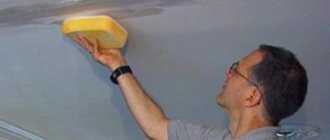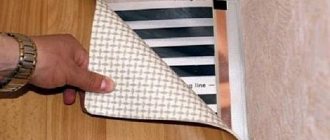After laying the flooring, all that remains is to give it a finished look. To do this, skirting boards are attached around the perimeter of the room, and the joints are masked using special thresholds. Linoleum often has a joint at the border of two rooms or when creating a combined floor covering when combined with tiles, carpet or laminate. Today's material is about what kind of threshold for linoleum is, how to use and fasten it.
Threshold for linoleum
Main functions of thresholds
The threshold for linoleum has many different functions, among which are:
- Aesthetic;
- Protective;
- Leveling;
- Designer.
The threshold strip is a mandatory decorative element. Even tightly connected linoleum joints create a feeling of incompleteness.
Connecting flooring seams
The protective function is expressed in reducing the penetration of dirt and dust into the joint, as well as moisture, which can lead to the appearance of mold and mildew.
Often, when laying floor coverings of different thicknesses, a height difference occurs, which can be handled well by a properly selected multi-level threshold.
“Smoothing” height differences
Also, using a plank, you can reduce the contrast between linoleum of different colors and textures.
Decorative thresholds
If cracks near the walls can be sealed using skirting boards, then under the doors you will need to use decorative thresholds. Interior thresholds for linoleum and other coverings are installed for a specific purpose.
They are installed at the very end of the work, and the purpose is quite clear: to block the joints from getting dirt, moisture, dust, etc. into them. Today, there are many varieties of such decorative elements, distinguished by material, design, type and other parameters.
It is quite difficult to select a threshold that suits all the conditions of a room, and most often two rooms at once. It is worth considering that usually dissimilar coatings are joined together, different not only in structure, but also in height. In order to cover this difference, the threshold is also selected.
Joints cannot be avoided during installation, and therefore it is necessary to take care of a high-quality method for sealing them. If the whole house is covered with ordinary linoleum, then it is enough to solder the sheets. In cases where there are other types of floor covering materials, a linoleum threshold is simply necessary.
Types of profiles
On the construction market you can find parts for decorating the seams of different types of floor coverings, which have different functional characteristics from each other.
Direct
This type of profile can be used to connect one or different materials that are at the same level from the floor.
Finishing
This type of lath is used in places where it is not necessary to join linoleum with another coating. Usually it is placed in the doorway.
Variable
Installed if you need to connect coatings with different heights. The connection of tiles or parquet with linoleum is carried out with this type of threshold.
Changeover connection between kitchen and living room
Corner
This type of profile is a corner and is attached when joining materials on staircase openings.
Correct placement of carpet
First you need to correctly position the carpet on the floor in the room where you are going to lay it. make sure that the seam is on the side where there is less foot traffic, for example, somewhere under furniture. Because if you hide the joint, it will not be noticeable, because even the most ideal joint is still visible. Arrange two rolls of carpet so that one overlaps the other by about seven centimeters. When joining, remember that the pile should be directed towards the joint. If the coating has a pattern, it must match.
Using chalk, draw a cutting line; it should be at least half the width of the overlap. Now using a sharp knife or blade, cut the piece along the line. This will be your new edge, so cut as straight as possible. Then you need to cut off the lower part of the carpet; to do this, press the upper part very tightly and cut off the carpet. You can make several cuts along the entire length so that they are like a cutting line. Now the pieces of your covering should match perfectly. You can carefully lift up the carpet and draw a chalk line on the floor, along the entire length of the edge. But you can do without it if the carpet does not bend.
Material
Linoleum planks are produced from different materials, which have their own technical characteristics.
Metal
Most often, aluminum or brass is used in the manufacture of linoleum thresholds. It is chosen because of its beautiful appearance and long service life. Also, such slats are not susceptible to rust. When producing a metal threshold, it is painted gold, silver, bronze or other colors. Lamination allows you to make slats that imitate the structure of wood, stone or other natural material.
Aluminum profile
Plastic
For the plastic strip, polyvinyl chloride is chosen. This is one of the available materials that has a wide selection of colors for decoration. To obtain a variety of colors, dyes are added to the plastic composition. Such a threshold is usually installed at the joints of two different materials. For example, carpet and linoleum, tiles and laminate, and other combinations. The advantage of this plank is its flexibility, which allows you to hide any curved joints.
Variety of plastic thresholds
Among the disadvantages, one can note their short service life due to the fragility of the material from which the plank is made. It may chip at the edges and change color. But the low cost of the threshold for connecting linoleum makes it possible to change them frequently.
Wood or MDF
Wooden floor thresholds for linoleum are practically not used anymore. They were popular in the post-Soviet space. Then it was the most affordable way to hide any joints. Now they are used only if you need to decorate laminate or parquet. Thresholds are made from different types of wood.
The disadvantage of such a slats is the high cost and the need for periodic restoration (cleaning, applying varnish, treating with protective agents).
Wooden straight sill
An MDF threshold is used when working with parquet, although it can be used between laminate and linoleum. They are relatively inexpensive, but their service life is short. This type of rail cannot withstand water and mechanical loads.
Cork
The use of a cork strip gives it shock-absorbing properties. Therefore, another name for the threshold is compensation rail. They have different shapes and sizes. Such strips, like rubber ones, are glued to the floor.
Rubber
There are two types of strips made from rubber. They can be made entirely of rubber or with an aluminum base. Rubber strips are glued to the floor, and slats with an aluminum base are attached using self-tapping screws. They additionally perform an anti-slip function. Such a flexible threshold for linoleum will help hide any uneven joints.
Flexible strips for uneven joints
The presence of a large number of different materials from which thresholds are made makes it possible to solve the problem of joining coatings not only aesthetically, but also functionally.
Reviews
Semyon Aleksandrovich, Novoshakhtinsk: “I made myself a linoleum strip from the remains of a polycarbonate sheet. It took some work, but it was worth it. Previously there were plastic thresholds, and no matter how you choose the color, it still won’t match the linoleum. I was really annoyed by the appearance of the pads and really wanted to get rid of them. I installed transparent thresholds and the appearance of the floor immediately changed. You’re right, once a year you have to polish the scratches all around, but it only takes 5 minutes.”
Ivan Petrovich, Kursk: “Plastic is no good, it starts to come off quickly, and you need to install metal thresholds, preferably with PVC or polyurethane film. In this case, the film is glued after tightening the screws, and they are not visible, but the threshold will be firmly pressed to the floor surface and will not dangle, as in grooved models. If you coat everything with silicone, then neither water nor debris will get under the linoleum, because it’s more expensive to install curved plastic strips.”
Price
The cost of thresholds may depend on the material, manufacturer and type of fastening. Below is an approximate price for linoleum planks depending on the manufacturer.
| Manufacturer, country | Type | Material | type of instalation | Size, mm | price, rub. |
| Balterio, Belgium | Finishing | plastic | hidden | 2400x31x10 | 143,00 |
| Balterio, Belgium | connective | plastic | hidden | 2400x44x12 | 950,00 |
| Poland | aluminum | metal | open | 90x38x16 | 120,00 |
| Luka, Russia | Threshold PS-03 | metal | open | 135x38x16 | 121,00 |
| Luka, Russia | Internal corner | metal | open | 20x20 | 127,00 |
When choosing a threshold, you should take into account the characteristics of the room in which it will be installed. The main thing to remember is that correctly selected and installed slats will protect not only the floor, but will also save the buyer from disappointment.
Laying without slats
The joints between linoleum and laminate can be formed without special strips. This option is more expensive due to the fact that there will be more waste during cutting. When laying the material, you must ensure that the direction of the pattern and the board coincide. In this case, the styling will be not only smooth, but also very attractive. You need to think about the direction in advance. For example, when laying in corridors or hallways, it is necessary to ensure that the laminate boards run lengthwise and not across.
Laminate without thresholds is easy to install, but linoleum is almost impossible, since it is necessary to ensure maximum fastening of the edges. For example, when joining near doorways, you will not only have to make a careful and very even cut, but also ensure fixation to the floor. Typically, silicone transparent glue is used for this. After the linoleum at the junction with the laminate is glued to the surface, it is necessary to additionally fill the gap between them with this adhesive, but make sure that it does not get on the outer parts. To do this, use masking tape, which is first glued to the joint area. After it is processed, the tape is cut with a knife along the joint. Attention will not hurt here; the coating should not be damaged. The entire joint is filled with silicone glue, and the tape is carefully removed.
Various methods are used to join laminate and linoleum. Their choice depends on what kind of material will be used for flooring and under what conditions this is carried out. For example, the most popular is the connection using strips that are simply attached at the joint. There are options when the joint is simply secured with silicone transparent glue. The latter method is more expensive, but it allows you to make the connection almost uniform.
Article on the topic: Self-adhesive wallpaper: adhesive for walls and furniture, adhesive film for the kitchen, photo, how to glue, can film be applied to wallpaper, video, brick-like, how to remove from the wall
Mounting methods
There are many ways to set the bar. You can get a beautiful decorative joint only with proper fastening of the threshold.
The method depends on the type of connection
Adhesive
To attach the threshold to the linoleum using this method, liquid nails are used at the junction of two coverings on the floor. This method does not provide the necessary grip, but is used if the floor is loose and it is not possible to use self-tapping screws.
Through
This method of fastening involves placing a strip over the joint and installing it on self-tapping screws, which are installed in holes drilled through in the threshold.
Open (secret)
This type of fastening consists of a main and decorative part. First, the main strip is installed with self-tapping screws, and then a decorative threshold is put on top.
Hidden fastening
Installation features
A strong and beautiful connection of two panels can only be achieved if the threshold is properly fixed. There are different mounting methods:
- With the through method of fixation (open), the threshold is fastened with self-tapping screws through the strips. The fasteners remain visible. If you match them to the threshold (often these are the screws included in the kit), then the plank will look neat.
Open mounting method
Fastening flexible PVC threshold
Fastening flexible PVC threshold
The straight aluminum threshold is fastened using an open method. This means that the fasteners remain outside.
“Quick installation” set
The threshold has ready-made holes and a set of screws with dowels.
Finished hole in aluminum sill
First, using a tape measure, you will need to measure the existing opening and trim the threshold if it is longer.
Measuring the width of the opening using a tape measure
When cutting the threshold, markings are applied to its reverse side using a ruler so that the edge is even and makes an angle of 90 degrees with the long side.
Marking the sill before trimming
After trimming, the threshold is placed in the opening in the position in which it will be fixed. To make the threshold look neat, the doorway is carefully filed on both sides and the edges of the product are pushed in there. This way, the sawn edges will not be noticeable.
Trimming the door frame
In order for the threshold to be fixed evenly, it is necessary to apply appropriate markings to the floor surface. First, mark the locations of the finished holes (1), and then, focusing on these notches, draw a straight line along the threshold.
From the resulting line, use a tape measure to measure the width of the threshold.
To determine the middle of the sill, measure the width of the product from the resulting line and make the required mark
Based on the markings, holes for fasteners are drilled in the base.
Preparing the hole for fasteners
A plastic dowel is inserted into the resulting hole.
Plastic dowel for self-tapping screw
After this, the threshold is installed in the required position.
The hole on the threshold must be located strictly above the dowel
Then fix the threshold using a self-tapping screw.
Thresholds with a hidden type of fastening are installed differently. The kit also includes fastening elements for this threshold.
Threshold for hidden fastening
Table 4. Hidden Threshold Mounting
| Illustration | Description |
| The product is placed in the opening and a pencil line is drawn along it. | |
| Use a tape measure to measure the width of the sill. | |
| Inside the joint, mark the middle of the threshold. | |
| Self-tapping screws are inserted into the groove on the back side of the decorative strip. | |
| The screws are installed in the position in which they will be located when attaching the threshold and markings for the holes in the seam. | |
| Drill holes. | |
| The dowel is inserted into the hole by moving the self-tapping screw along the internal groove of the sill. | |
| The threshold is driven into the specified position through the block with a hammer, tapping along its entire length. |
The simplest and fastest way to create a joint is to install a self-adhesive threshold. To do this, markings are made on the surface of the linoleum.
The protective film is removed from the surface of the back side of the sill.
Removing the protective film
After this, all that remains is to glue the product in accordance with the markings on the floor.
Fixing the threshold along the marking line
Prices for Tarkett linoleum
Setting thresholds
The most common way to install thresholds on dowels. For this purpose, an aluminum strip with a decorative overlay is used. The dowels will be hidden under the cover and will not spoil the visual appearance when inspecting the room.
The installation consists of the following steps:
- Seam measurements;
- Cutting the threshold to the required dimensions;
- Cleaning the seam from dirt and dust;
- Laying of the plank is done in the center on the seam with a mark of the place of installation;
- Places for dowels are marked;
- Using a drill, holes are made where fasteners need to be inserted;
- A protective strip is installed on the self-tapping screws.
Should I use glue?
When laying out the coating, you can either fix it with glue or not use this product. Those who prefer not to use glue believe that linoleum is successfully pressed against the legs of heavy furniture and large household appliances such as a washing machine, and it is not necessary to glue it. In principle, this is an acceptable option. However, in the summer, in the heat, the material expands from the heat, and then the objects fixing the linoleum move, without returning on their own when it gets colder, and then swellings appear on the linoleum.
So people in the know believe that the material needs to be glued. If you partially glue the coating, it will then become deformed. So you only need to glue it over the entire surface. When installing linoleum, glue is often used. Now you can choose any composition. Here the question naturally arises about the choice of glue. In any case, you need to use exactly the kind of glue so that it is well suited to the substrate. Before laying out, the roll needs to be kept unfolded for some time so that it has time to align. If the covering is glued, the seams will then be of high quality.
Pairing tiles and linoleum
Having figured out how to hide seams using a strip, you can move on to how to hide the connection between tiles and linoleum. Very often, when renovating, it is practiced to use different floor coverings, giving the premises an individual character.
Zoning of premises
Different materials are used to zone a room, for example, in the dining room, highlighting the dining and work areas. At the same time, in order for the finish to be aesthetically pleasing and complete, it is necessary to properly hide the transitions.
To connect different coatings, a special threshold made of MDF, wood or plastic is used. Thanks to the wide variety of materials, choosing a plank will not be difficult.
End-to-end installation process
Typically, coatings are connected along curved lines, as well as at an angle. It is better to hide uneven joints under rubber thresholds due to their natural flexibility. For even seams, you can use a threshold made of MDF, wood or metal.
Cork slats are produced with a thickness of 1 cm, but due to the properties of the material they can expand or contract. Therefore, they are often chosen for mounting on coverings of different heights. During the installation process, such a strip is placed on the covering, and the material that protrudes is strongly pressed. After pressing, the cork gets the desired shape, and then it can be glued to the joint.
Cork rail
The connecting threshold between ceramic tiles and other material can be installed not with self-tapping screws, but with glue, which will hermetically seal these coatings.
Did the article help you? ( 4 ratings, average: 5.00 out of 5)
Hot welding
This method is more complicated than others, but more reliable. Due to the need to use special equipment for hot welding, the method is rarely used for home coating. This method is in demand mainly in commercial premises. It is unsuitable for household linoleum: this coating is very thin, and it will melt due to too much heat.
Linoleum is first glued to the floor. Hot welding should not begin before the glue has dried. In this case, the canvases should be laid very tightly end-to-end, and not overlapping.
Here you will need the following equipment:
- a cutter that allows you to make grooves between the blades;
- manual machine for linoleum welding;
- a sickle-shaped knife that allows you to remove protruding glue.
You can hide linoleum joints using hot welding
The connecting material here is a special four-millimeter PVC cord. This type is sold in construction markets in coils of one hundred meters, and such coils are painted in any shade. The heat melts the cord, and it fills the joint between different pieces of coating. The cooled cord has all the same characteristics as linoleum.
Step-by-step instruction
Sequence of actions Description
Step 1
Make a groove with a cutter by cutting out a narrow piece of material, but not cutting all the way to the floor. If debris appears, remove it.
Step 2
Insert the hot welding cord into the welding machine.
Step 3
Place the nose of the device at the beginning of the groove, along which it is then guided. In the process, the groove is filled with molten cord.
Step 4
Along the way, material residues are formed; remove them with a knife or special device.
It is important to do this before the material hardens.











